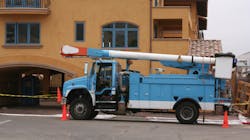The other day on the local news, I saw that Fort Wayne, Ind., utility trucks were jumping on the freeway heading to Kentucky and Tennessee to lend support to utilities in those states that were anticipating power lines being down because of an impending ice storm. Earlier in that same week, someone had mentioned that they thought utility trucks were perfect for electrification because they are owned by the utilities and usually don’t travel very far.
The key here is “usually” and that got me thinking about the importance of fully understanding duty cycle is not just looking at average trips or average days when making decisions on how to spec a vehicle.
On the surface it seems to make good sense to electrify all utility trucks because they don’t accumulate a lot of miles and they return to base, so charging is simplified. But the reality is that in times of emergency, utility trucks are sent far beyond their normal area of operation. If all the utility trucks were electric powered that sharing might not be able to happen. They couldn’t make the long-distance trip and unless the needed charging infrastructure was in place, couldn’t charge once they got there.
Does that mean that utilities should not begin moving to electrification? The answer is obviously, no. For most utility trucks, it is often business as usual and that means switching to battery-electric vehicles make a great deal of sense. However, if they are part of a bigger emergency response effort that requires trucks to move about the country as needed in response to emergency needs, then at this point going all electric is not an option.
Utilities — like most fleets — can’t afford to have extra equipment sitting around that does not get used, so it can be tricky to figure out just how many trucks in the fleet can be electric. The only way to make that decision is to do an in-depth analysis of how often a truck needs to be deployed in an emergency situation and then use that information to make sure there are the right mix of trucks in the fleet.
You can’t spec for the average or the usual. No matter what kind of fleet you are, you need to dive into the details of your operation to find the right mix of not only vehicles but powertrains that are going to allow you to operate both efficiently and profitably, all the while keeping in mind that we are moving to zero-emissions future in which electric vehicles will dominate.
I am not certain what the best solution to this is, but I do know that using “usuals or averages” solely won’t work. As a friend tells me often, there is no average truck, route or payload.
About the Author

Michael Roeth
Executive Director
Michael Roeth is the executive director of the North American Council for Freight Efficiency. He serves on the second National Academy of Sciences Committee on Technologies and Approaches for Reducing the Fuel Consumption of Medium and Heavy-Duty Vehicles and has held various positions with Navistar and Behr/Cummins.
